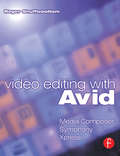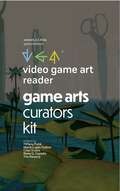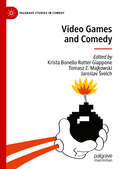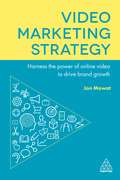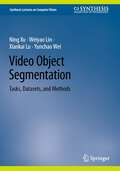- Table View
- List View
Video Coding with Superimposed Motion-Compensated Signals: Applications to H.264 and Beyond (The Springer International Series in Engineering and Computer Science #760)
by Markus Flierl Bernd GirodAppendices 133 A Mathematical Results 133 A.1 Singularities of the Displacement Error Covariance Matrix 133 A.2 A Class of Matrices and their Eigenvalues 134 A.3 Inverse of the Power Spectral Density Matrix 134 A.4 Power Spectral Density of a Frame 136 Glossary 137 References 141 Index 159 Preface This book aims to capture recent advances in motion compensation for - ficient video compression. It investigates linearly combined motion comp- sated signals and generalizes the well known superposition for bidirectional prediction in B-pictures. The number of superimposed signals and the sel- tion of reference pictures will be important aspects of the discussion. The application oriented part of the book employs this concept to the well known ITU-T Recommendation H.263 and continues with the improvements by superimposed motion-compensated signals for the emerging ITU-T R- ommendation H.264 and ISO/IEC MPEG-4 (Part 10). In addition, it discusses a new approach for wavelet-based video coding. This technology is currently investigated by MPEG to develop a new video compression standard for the mid-term future.
Video Content Analysis Using Multimodal Information: For Movie Content Extraction, Indexing and Representation
by Ying Li C.C. Jay KuoVideo Editing with Avid: Media Composer, Symphony, Xpress
by Roger ShufflebottomThis is the first comprehensive guide to editing on Avid from a PAL standpoint, also including NTSC information where appropriate, making this book a worldwide manual.If you are already using Media Composer, Symphony, or Xpress and want to improve and consolidate your basic methods, or if you need to learn these systems from scratch, then this book is for you. This invaluable reference source explains, from beginner to intermediate level, the similarities and differences of these three packages and will ensure you get the most out of your Avid system. Based on his experience as a film and video editor and trainer, Roger Shufflebottom imparts all the information you need in a clear, accurate and easy to follow format. He provides a comprehensive guide to all the main editing tools of Media Composer, Symphony and Xpress. The text covers Media Composer versions 7-10, Xpress versions 2-4, and Symphony versions 1-3. Extra information is also included on Media Composer version 10.5, Symphony version 3.5 and Xpress version 4.5. Specific Apple Mac and Windows NT information is included.Moving beyond basic editing, 2D effects, 3D effects and graphic import are explained in detail. By working through the text you will be able to complete an Avid project competently and intuitively and you will learn some efficient and powerful working techniques.Roger Shufflebottom has been an editor since 1974, began training in 1993 and has run courses for major broadcasters including the BBC, Carlton, BskyB, Pearson Television and the American Forces Network as well as many facility companies. He is an Avid Certified Instructor and has written many articles for 'Avid User' magazine.
Video Editing with Avid: Media Composer, Symphony, Xpress
by Roger ShufflebottomThis is the first comprehensive guide to editing on Avid from a PAL standpoint, also including NTSC information where appropriate, making this book a worldwide manual.If you are already using Media Composer, Symphony, or Xpress and want to improve and consolidate your basic methods, or if you need to learn these systems from scratch, then this book is for you. This invaluable reference source explains, from beginner to intermediate level, the similarities and differences of these three packages and will ensure you get the most out of your Avid system. Based on his experience as a film and video editor and trainer, Roger Shufflebottom imparts all the information you need in a clear, accurate and easy to follow format. He provides a comprehensive guide to all the main editing tools of Media Composer, Symphony and Xpress. The text covers Media Composer versions 7-10, Xpress versions 2-4, and Symphony versions 1-3. Extra information is also included on Media Composer version 10.5, Symphony version 3.5 and Xpress version 4.5. Specific Apple Mac and Windows NT information is included.Moving beyond basic editing, 2D effects, 3D effects and graphic import are explained in detail. By working through the text you will be able to complete an Avid project competently and intuitively and you will learn some efficient and powerful working techniques.Roger Shufflebottom has been an editor since 1974, began training in 1993 and has run courses for major broadcasters including the BBC, Carlton, BskyB, Pearson Television and the American Forces Network as well as many facility companies. He is an Avid Certified Instructor and has written many articles for 'Avid User' magazine.
Video Field Production and Editing
by Ronald CompesiVideo Field Production and Editing concentrates on video techniques and technology appropriate for "small scale" single-camera electronic field production (EFP) and electronic news gathering (ENG). This book offers the latest material on new digital field recording and editing technologies and is written in a concise, non-technical, user-friendly format. Reorganized and updated throughout, with new sections dedicated to HDV (High Definition Video) videotape recording formats, and tapeless digital recording media including high capacity optical discs, solid-state memory cards, and computer hard drives, the book walks the reader through the video production process from initial planning through final editing.
Video Field Production and Editing
by Ronald CompesiVideo Field Production and Editing concentrates on video techniques and technology appropriate for "small scale" single-camera electronic field production (EFP) and electronic news gathering (ENG). This book offers the latest material on new digital field recording and editing technologies and is written in a concise, non-technical, user-friendly format. Reorganized and updated throughout, with new sections dedicated to HDV (High Definition Video) videotape recording formats, and tapeless digital recording media including high capacity optical discs, solid-state memory cards, and computer hard drives, the book walks the reader through the video production process from initial planning through final editing.
Video Field Production and Editing
by Ronald J. CompesiIn the eighth, revised edition of this book, Ronald J. Compesi offers a comprehensive and in-depth introduction to the aesthetics of small-scale, single-camera video production in field environments, from planning through postproduction, in a range of different programming formats. Written in an accessible, student-friendly style, this new edition has been significantly updated and revised throughout to reflect current technology and industry practices, including shooting with DSLR cameras, in HD and on smartphones, new methods and channels of distribution, and much more. Key features and updates to the eighth edition include: A focus on small-scale video production, involving a minimum amount of field equipment and a small crew, offering creative solutions for video producers with limited resources and personnel; Discussions of HD and 4K technology/acquisition, LED lighting, shooting with DSLR cameras and smartphones, new online distribution channels; Over 300 photos and line art, in full-color for the first time, illustrating production processes, technical issues and equipment, and illuminating key aesthetic elements; An eResource with downloadable production planning documents, links to further online resources, production project exercises, and sample test questions. With over 40 years of teaching and production experience, Ronald J. Compesi offers an up-to-date and essential introduction to the art of small-scale video production in field environments in the new edition of this groundbreaking text, in print since 1985.
Video Field Production and Editing
by Ronald J. CompesiIn the eighth, revised edition of this book, Ronald J. Compesi offers a comprehensive and in-depth introduction to the aesthetics of small-scale, single-camera video production in field environments, from planning through postproduction, in a range of different programming formats. Written in an accessible, student-friendly style, this new edition has been significantly updated and revised throughout to reflect current technology and industry practices, including shooting with DSLR cameras, in HD and on smartphones, new methods and channels of distribution, and much more. Key features and updates to the eighth edition include: A focus on small-scale video production, involving a minimum amount of field equipment and a small crew, offering creative solutions for video producers with limited resources and personnel; Discussions of HD and 4K technology/acquisition, LED lighting, shooting with DSLR cameras and smartphones, new online distribution channels; Over 300 photos and line art, in full-color for the first time, illustrating production processes, technical issues and equipment, and illuminating key aesthetic elements; An eResource with downloadable production planning documents, links to further online resources, production project exercises, and sample test questions. With over 40 years of teaching and production experience, Ronald J. Compesi offers an up-to-date and essential introduction to the art of small-scale video production in field environments in the new edition of this groundbreaking text, in print since 1985.
Video for Change: A Guide For Advocacy and Activism
by Sam Gregory Gillian Caldwell Ronit Avni Thomas Harding WitnessPictures from Abu Ghraib showed the power of the amateur image to grab the world's attention. The Asian tsunami, caught on camcorder, brought home the reality of what had happened more than any news report ever could. Around the world the increasing availability and affordability of technology has fuelled the world of social justice video activism. Film-making - at its best - has the power to change the way people think, and create real social change, and now the tools to do it are more accessible than ever before. This book shows how activists and human rights campaigners can harness the power of images and stories for their own purposes - it's a step-by-step guide to the handicam revolution.*BR**BR*Written by leading video activists, and staff of the world-renowned human rights organization WITNESS, this practical handbook will appeal to experienced campaigners as well as aspiring video activists. It combines a comprehensive analysis of what's going on in this growing global field with a how-to primer to doing it yourself.*BR*
Video Game Art Reader: Volume 3
by Tiffany FunkThis special edition of the VGA Reader, guest-edited by Christopher W. Totten and Enrica Lovaglio Costello, focuses on the connections between video games and architectural design. Each of the essays in this volume engages in critical investigations that reveal how game spaces evoke meaning, enhance game narratives, and explore unconventional themes.
Video Game Art Reader: Volume 2
by Tiffany FunkThis volume of VGAR critically analyzes video game art as a means of survival. Though “survival strategy” exists as a defined gaming genre, all video games—as unique, participatory artworks—model both individual and collaborative means of survival through play. Video games offer opportunities to navigate both historical and fictional conflicts, traverse landscapes devastated by climate change or nuclear holocaust, and manage the limited resources of individuals or even whole civilizations on earth and beyond. They offer players a dizzying array of dystopian scenarios in which to build and invent, cooperate with others (through other players, NPCs, or AI) to survive another day. Contributors show how video games focus attention, hone visuospatial skills, and shape cognitive control and physical reflexes and thus have the power to participate in the larger context of radical, activist artworks that challenge destructive hegemonic structures as methods of human conditioning, coping, and creating.
Video Game Art Reader: Volume 1
by Tiffany FunkThe inaugural issue of VGAR celebrates video game culture as inclusive and global. Opening with an interview with the art director of the first independent Cuban video game, Savior, while the following essays from art historians, literary theorists, game designers, artists, educators, museum curators, and programmers all engage with video games as an important part of the global art landscape. Each engages with what makes good game art with special attention to the transnational cadre of gamers that play them.
Video Game Art Reader: Volume 4
by Tiffany FunkIn computing, overclocking refers to the common practice of increasing the clock rate of a computer to exceed that certified by the manufacturer. The concept is seductive but overclocking may destroy your motherboard or system memory, even irreparably corrupt the hard drive. Volume 4 of the Video Game Art Reader (VGAR) proposes overclocking as a metaphor for how games are produced and experienced today, and the temporal compressions and expansions of the many historical lineages that have shaped game art and culture. Contributors reflect on the many ways in which overclocking can be read as a means of oppression but also a strategy to raise awareness of how inequities have shaped video games.
Video Game Art Reader: Volume 5: The Game Art Curators Kit
by Tiffany FunkMany ambitious and experimental game forms don't fit into the digital download or retail distribution channels that support so-called “traditional” video games. Instead, these games are supported by a new global movement in video game curation. This special edition of the Video Game Art Reader features an international collaboration of video game professionals working together to create a resource for game exhibition organization, design, and curation. Professionals, artists, and others who organize and curate video game exhibitions and events act within a rhizomatic network of methods, missions, and goals. They establish organizations like galleries, collectives, and non-profits. Methods of sharing video games as critical cultural phenomena continue to evolve and expand. Conceived during the first meeting of GAIA (Game Arts International Assembly), the Game Art Curators Kit documents and shares the collective experience of an international network of video game curators and organizers. Sharing practical tips on everything from accessibility to preservation, the book also serves as a guide to support a new global movement in video game curation.
Video Game Design: Principles and Practices from the Ground Up (Required Reading Range)
by Michael SalmondVideo Game Design is a visual introduction to integrating core design essentials, such as critical analysis, mechanics and aesthetics, prototyping, level design, into game design. Using a raft of examples from a diverse range of leading international creatives and award-winning studios, this is a must-have guide for budding game designers. Industry perspectives from game industry professionals provide fascinating insights into this creative field, and each chapter concludes with a workshop project to help you put what you've learnt into practice to plan and develop your own games.With over 200 images from some of the best-selling, most creative games of the last 30 years, this is an essential introduction to industry practice, helping readers develop practical skills for video game creation. This book is for those seeking a career making video games as part of a studio, small team or as an independent creator. It will guide you from understanding how games engage, entertain and communicate with their audience and take you on a journey as a designer towards creating your own video game experiences.Interviewees include:James Portnow, CEO at Rainmaker GamesBrandon Sheffield, Gamasutra.com/Game Developer magazineSteve Gaynor, co-founder The Fullbright Company (Gone Home)Kate Craig, Environment Artist. The Fullbright Company (Gone Home)Adam Saltsman, creator of Canabalt & Gravity HookJake Elliott & Tamas Kemenczy, Cardboard Computer (Kentucky Route Zero)Tyson Steele, User Interface Designer, Epic GamesTom Francis, Game Designer, Gunpoint & Floating PointKareem Ettouney, Art Director, Media Molecule. Little Big Planet 1 & 2, Tearaway.Kenneth Young, Head of Audio, Media MoleculeRex Crowle, Creative Lead, Media Molecule
Video Game Design: Principles and Practices from the Ground Up (Required Reading Range Ser.)
by Michael SalmondVideo Game Design is a visual introduction to integrating core design essentials, such as critical analysis, mechanics and aesthetics, prototyping, level design, into game design. Using a raft of examples from a diverse range of leading international creatives and award-winning studios, this is a must-have guide for budding game designers. Industry perspectives from game industry professionals provide fascinating insights into this creative field, and each chapter concludes with a workshop project to help you put what you've learnt into practice to plan and develop your own games.With over 200 images from some of the best-selling, most creative games of the last 30 years, this is an essential introduction to industry practice, helping readers develop practical skills for video game creation. This book is for those seeking a career making video games as part of a studio, small team or as an independent creator. It will guide you from understanding how games engage, entertain and communicate with their audience and take you on a journey as a designer towards creating your own video game experiences.Interviewees include:James Portnow, CEO at Rainmaker GamesBrandon Sheffield, Gamasutra.com/Game Developer magazineSteve Gaynor, co-founder The Fullbright Company (Gone Home)Kate Craig, Environment Artist. The Fullbright Company (Gone Home)Adam Saltsman, creator of Canabalt & Gravity HookJake Elliott & Tamas Kemenczy, Cardboard Computer (Kentucky Route Zero)Tyson Steele, User Interface Designer, Epic GamesTom Francis, Game Designer, Gunpoint & Floating PointKareem Ettouney, Art Director, Media Molecule. Little Big Planet 1 & 2, Tearaway.Kenneth Young, Head of Audio, Media MoleculeRex Crowle, Creative Lead, Media Molecule
Video Game Level Design: How to Create Video Games with Emotion, Interaction, and Engagement
by Michael SalmondLevel design connects the player to the game through challenges, experiences, and emotions. This book is an invaluable introduction to the evolving practices of Level Designers across the games industry. The increasingly complex role of the Level Designer requires technical and creative skill as it brings together architecture, art, player psychology, interaction design, usability, and experience design. This book explores in detail the principles designers employ when planning levels and building engaging spaces for the player. As well as practical approaches to level design, the book delves into the theoretical underpinnings of the processes and charts a path towards thinking like a Level Designer. Throughout the book you will be guided through the fundamentals of level design: each chapter builds on the types of research, ideation, best practices, and methodologies Level Designers employ when creating prototypes and shipped games. A series of interviews with designers and case studies from game studios examine the application of industry-wide expertise used to create triple-A and indie game titles. By the end of this book you will have gained valuable insight into the role of a Level Designer and be able to devise, plan, and build your own engaging and entertaining game levels.
Video Game Level Design: How to Create Video Games with Emotion, Interaction, and Engagement
by Michael SalmondLevel design connects the player to the game through challenges, experiences, and emotions. This book is an invaluable introduction to the evolving practices of Level Designers across the games industry. The increasingly complex role of the Level Designer requires technical and creative skill as it brings together architecture, art, player psychology, interaction design, usability, and experience design. This book explores in detail the principles designers employ when planning levels and building engaging spaces for the player. As well as practical approaches to level design, the book delves into the theoretical underpinnings of the processes and charts a path towards thinking like a Level Designer. Throughout the book you will be guided through the fundamentals of level design: each chapter builds on the types of research, ideation, best practices, and methodologies Level Designers employ when creating prototypes and shipped games. A series of interviews with designers and case studies from game studios examine the application of industry-wide expertise used to create triple-A and indie game titles. By the end of this book you will have gained valuable insight into the role of a Level Designer and be able to devise, plan, and build your own engaging and entertaining game levels.
Video Games and Comedy (Palgrave Studies in Comedy)
by Krista Bonello Rutter Giappone Tomasz Z. Majkowski Jaroslav ŠvelchVideo Games and Comedy is the first edited volume to explore the intersections between comedy and video games. This pioneering book collects chapters from a diverse group of scholars, covering a wide range of approaches and examining the relationship between video games, humour, and comedy from many different angles. The first section of the book includes chapters that engage with theories of comedy and humour, adapting them to the specifics of the video game medium. The second section explores humour in the contexts, cultures, and communities that give rise to and spring up around video games, focusing on phenomena such as in-jokes, player self-reflexivity, and player/fan creativity. The third section offers case studies of individual games or game series, exploring the use of irony as well as sexual and racial humour in video games.
Video Games and Storytelling: Reading Games and Playing Books
by Souvik MukherjeeThe potential of video games as storytelling media and the deep involvement that players feel when they are part of the story needs to be analysed vis-à-vis other narrative media. This book underscores the importance of video games as narratives and offers a framework for analysing the many-ended stories that often redefine real and virtual lives.
Video Image Detection Systems Installation Performance Criteria (SpringerBriefs in Fire #0)
by Daniel T. GottukComputer processing and image analysis technologies have improved substantially over the course of the past decade. This rapidly advancing technology along with the emphasis on video surveillance since 911 has propelled the development of effective video image detection (VID) systems for ?re. Fire protection system designers initially employed these VID systems for use in large facilities, outdoor locations and tunnels. However, video-based detection is being used for a broadening range of applications [e. g. , 1]. For example, these systems are c- rently installed in electrical power plants, paper mills, document storage facilities, historic municipal buildings, nuclear research facilities, automotive plants, wa- house/distribution centers, and onshore and offshore oil platforms. The 2007 edition of NFPA 72, National Fire Alarm Code [2], recognized the use of VID systems for ?ame and smoke detection. Although recognized, there is limited prescriptive installation and use requirements and there is a general desire by many for the development of performance criteria that ultimately could be utilized for the design of systems or the creation of standards. Since the underlying VID technology and development of standard and network-based camera systems are in a period of fairly rapid advancement [3–5], it is not possible to de?ne a comprehensive set of stand-alone prescriptive requirements. The performance of VID systems depends on both the video hardware and the software algorithms; there is no basic underlying principle, such as there is for ionization or pho- electric detection for smoke detectors. Consequently, performance-based inst- lation and operation requirements are needed.
Video Marketing Strategy: Harness the Power of Online Video to Drive Brand Growth
by Jon MowatVideo is the single most effective tool that marketers have to raise brand awareness, increase sales, drive website traffic and deliver ROI on marketing budgets. Driven by consumer demand and with the backing of the largest social media platforms, our world is becoming 'video first'. Video Marketing Strategy allows marketers to harness the power of video and create effective video campaigns. This in-depth look at the world's most powerful medium helps brands to radically magnify their voice by tapping into a level of emotional engagement that can't be achieved any other way. The book explores both theory (why are humans so affected by video on mobile devices?) and practice (what's the key to making videos that deliver results?). It looks at how multiple videos form wider campaigns and covers content hubs, activation strategies and testing. It is filled with invaluable advice, tips and strategies for incorporating video into a wider content marketing plan. Written by an award-winning video marketer with decades of experience, Video Marketing Strategy gives readers the magic formula to create engaging, effective content. Truly global in scope, it features case studies from around the world, and shows how marketers from all sectors and industries have used video campaigns successfully. Featuring insights from prominent industry practitioners Video Marketing Strategy is jam-packed with guidance on how to make videos that cut through the market place and deliver measurable results.
Video Marketing Strategy: Harness the Power of Online Video to Drive Brand Growth
by Jon MowatVideo is the single most effective tool that marketers have to raise brand awareness, increase sales, drive website traffic and deliver ROI on marketing budgets. Driven by consumer demand and with the backing of the largest social media platforms, our world is becoming 'video first'. Video Marketing Strategy allows marketers to harness the power of video and create effective video campaigns. This in-depth look at the world's most powerful medium helps brands to radically magnify their voice by tapping into a level of emotional engagement that can't be achieved any other way. The book explores both theory (why are humans so affected by video on mobile devices?) and practice (what's the key to making videos that deliver results?). It looks at how multiple videos form wider campaigns and covers content hubs, activation strategies and testing. It is filled with invaluable advice, tips and strategies for incorporating video into a wider content marketing plan. Written by an award-winning video marketer with decades of experience, Video Marketing Strategy gives readers the magic formula to create engaging, effective content. Truly global in scope, it features case studies from around the world, and shows how marketers from all sectors and industries have used video campaigns successfully. Featuring insights from prominent industry practitioners Video Marketing Strategy is jam-packed with guidance on how to make videos that cut through the market place and deliver measurable results.
Video Object Extraction and Representation: Theory and Applications (The Springer International Series in Engineering and Computer Science #584)
by I-Jong Lin S.Y. Kung“If you have built castles in the air, your work need not be lost; that is where they should be. Now put the foundations under them. ” - Henry David Thoreau, Walden Although engineering is a study entrenched firmly in belief of pr- matism, I have always believed its impact need not be limited to pr- matism. Pragmatism is not the boundaries that define engineering, just the (sometimes unforgiving) rules by which we sight our goals. This book studies two major problems of content-based video proce- ing for a media-based technology: Video Object Plane (VOP) Extr- tion and Representation, in support of the MPEG-4 and MPEG-7 video standards, respectively. After reviewing relevant image and video p- cessing techniques, we introduce the concept of Voronoi Ordered Spaces for both VOP extraction and representation to integrate shape infor- tion into low-level optimization algorithms and to derive robust shape descriptors, respectively. We implement a video object segmentation system with a novel surface optimization scheme that integrates Voronoi Ordered Spaces with existing techniques to balance visual information against predictions of models of a priori information. With these VOPs, we have explicit forms of video objects that give users the ability to - dress and manipulate video content. We outline a general methodology of robust data representation and comparison through the concept of complex partitioning mapped onto Directed Acyclic Graphs (DAGs).
Video Object Segmentation: Tasks, Datasets, and Methods (Synthesis Lectures on Computer Vision)
by Ning Xu Weiyao Lin Xiankai Lu Yunchao WeiThis book provides a thorough overview of recent progress in video object segmentation, providing researchers and industrial practitioners with thorough information on the most important problems and developed technologies in the area. Video segmentation is a fundamental topic for video understanding in computer vision. Segmenting unique objects in a given video is useful for a variety of applications, including video conference, video editing, surveillance, and autonomous driving. Given the revolution of deep learning in computer vision problems, numerous new tasks, datasets, and methods have been recently proposed in the domain of segmentation. The book includes these recent results and findings in large-scale video object segmentation as well as benchmarks in large-scale human-centric video analysis in complex events. The authors provide readers with a comprehensive understanding of the challenges involved in video object segmentation, as well as the most effective methods for resolving them.


